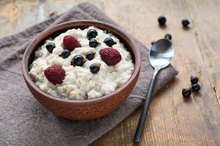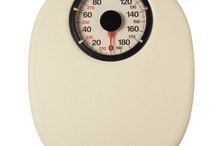Benefits of Increased Blood Circulation
Blood circulation is an important part of your body's overall function and health. Your heart pumps blood through blood vessels within your circulatory system. Red blood cells have specific tasks of carrying oxygen to your body’s vital organs, providing vitality and energy, explains the National Library of Medicine. When your vital organs and circulatory system work in unison, you have an adequate blood flow. If you have a disease or condition that affects the circulatory system, blood flow may decrease.
Significance
An increase in blood flow or circulation in the body can help benefit the heart and the body’s muscles and arteries throughout the body. Increased blood circulation improves oxygen rich blood flow to extremities. You may experience an increase in blood flow to vital organs when you improve oxygen levels in your blood by exercising muscles and working out. Working out your muscles and increasing your aerobic activity can help with blood circulation.
- An increase in blood flow or circulation in the body can help benefit the heart and the body’s muscles and arteries throughout the body.
- Working out your muscles and increasing your aerobic activity can help with blood circulation.
Causes of Poor Blood Circulation
Can Fish Oil Help With Poor Blood Circulation?
Learn More
There are several medical conditions that slow down or block blood circulation, explains MayoClinic.com. One of the most dangerous is formation of a blood clot. A blood clot will stop or inhibit blood flow from one part of your body to the remaining areas, causing a stroke or severe damage to your arteries. Other causes of poor blood circulation include Raynaud's Disease, where arteries that supply oxygen-rich blood narrow; heart disease; and deep vein thrombosis.
- There are several medical conditions that slow down or block blood circulation, explains MayoClinic.com.
- A blood clot will stop or inhibit blood flow from one part of your body to the remaining areas, causing a stroke or severe damage to your arteries.
Benefits of Blood Circulation
Having an increase in blood flow and circulation to areas of your body helps promote cell growth and organ function. Your skin also benefits from an increase in blood circulation. Healthy skin is better able to fight off bacteria and infection that it may come in contact with. When your heart pumps at full force, your heart rate lowers, heart muscles relax and your blood pressure flows evenly and smoothly.
- Having an increase in blood flow and circulation to areas of your body helps promote cell growth and organ function.
Diabetes and Blood Circulation
Definition of Personal Hygiene
Learn More
If you have diabetes, you need to pay special attention to your health, including your blood circulation, by making frequent visits to your doctor. Diabetes can cause poor blood circulation throughout your body, but specifically in your legs and feet, explains the American Diabetes Association. Getting adequate exercise will help improve blood flow to your extremities and help reduce the risk for diabetic health complications.
Effects
Having increased blood circulation throughout your body will help you look and feel healthy. Your skin will have a healthy color and you will feel warm to the touch. Good blood circulation helps improve brain function and helps keep your mind sharp and focused. You will also be more equipped to handle stressful situations.
- Having increased blood circulation throughout your body will help you look and feel healthy.
- Your skin will have a healthy color and you will feel warm to the touch.
Related Articles
References
- National Library of Medicine: Blood Circulation
- MayoClinic.com: Blood Clots
- MayoClinic.com: Raynaud's Disease
- National Heart, Lung, and Blood Institute. Low blood pressure.
- National Heart, Lung, and Blood Institute. Low blood pressure.
- National Kidney Foundation. Acute Kidney Injury (AKI).
- Jensen MT, Suadicani P, Hein HO, Gyntelberg F. Elevated resting heart rate, physical fitness and all-cause mortality: a 16-year follow-up in the Copenhagen Male Study. Heart. 2013;99(12):882-887. doi:10.1136/heartjnl-2012-303375
- Whelton PK, Carey RM, Aronow WS, et al. 2017 ACC/AHA/AAPA/ABC/ACPM/AGS/APhA/ASH/ASPC/NMA/PCNA Guideline for the prevention, detection, evaluation, and management of high blood pressure in adults: a report of the American College of Cardiology/American Heart Association Task Force on clinical practice guidelines. Hypertension. 2018;71(6):e13-e115. doi:10.1161/HYP.0000000000000065
- Michiels C. Physiological and pathological responses to hypoxia. Am J Pathol. 2004;164(6):1875-82. doi:10.1016/S0002-9440(10)63747-9
- Saljoughian M. Hypotension: A clinical care review. US Pharm. 2014;39(2):2-4.
- Kasper DL, Fauci AS, Stephen L. Harrison's Principles of Internal Medicine. New York: Mc Graw Hill Education, 2015.
Writer Bio
Julie Boehlke is a seasoned copywriter and content creator based in the Great Lakes state. She is a member of the Society of Professional Journalists. Boehlke has more than 10 years of professional writing experience on topics such as health and wellness, green living, gardening, genealogy, finances, relationships, world travel, golf, outdoors and interior decorating. She has also worked in geriatrics and hospice care.








